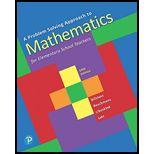
Concept explainers
A list of presidents, with the number of children for each, follows:
1. Washington, 0
2. J. Adams, 5
3. Jefferson, 6
4. Madison, 0
5. Monroe, 2
6. J. Q. Adams, 4
7. Jackson, 0
8. Van Buren, 4
9. W. H. Harrison, 10
10. Tyler, 15
11. Polk, 0
12. Taylor, 6
13. Fillmore, 2
14. Pierce, 3
15. Buchanan, 0
16. Lincoln, 4
17. A. Johnson, 5
18. Grant, 4
19. Hayes, 8
20. Garfield, 7
21. Arthur, 3
22. Cleveland, 5
23. B. Harrison, 3
24. McKinley, 2
25. T. Roosevelt, 6
26. Taft, 3
27. Wilson, 3
28. Harding, 0
29. Coolidge, 2
30. Hoover, 2
31. F. D. Roosevelt, 6
32. Truman, 1
33. Eisenhower, 2
34. Kennedy, 4
35. L. B. Johnson, 2
36. Nixon, 2
37. Ford, 4
38. Carter, 4
39. Reagan, 4
40. G. Bush, 5
41. Clinton, 1
42. G. W. Bush, 2
43. Obama, 2
44. Trump, 5
a. Construct a dot plot for these data.
b. Make a frequency table for these data.
c. What is the most frequent number of children?
Want to see the full answer?
Check out a sample textbook solution
Chapter 10 Solutions
Problem Solving Approach to Mathematics for Elementary School Teachers
- Solve the equation. Write the smaller answer first. 2 (x-6)² = 36 x = Α x = Previous Page Next Pagearrow_forwardWrite a quadratic equation in factored form that has solutions of x = 2 and x = = -3/5 ○ a) (x-2)(5x + 3) = 0 ○ b) (x + 2)(3x-5) = 0 O c) (x + 2)(5x -3) = 0 ○ d) (x-2)(3x + 5) = 0arrow_forwardA vacant lot is being converted into a community garden. The garden and a walkway around its perimeter have an area of 690 square feet. Find the width of the walkway (x) if the garden measures 14 feet wide by 18 feet long. Write answer to 2 decimal places. (Write the number without units). Hint: add 2x to each of the garden dimensions of 14 x 18 feet to get the total area for the length multiplied by width.arrow_forward
- Solve the rational equation 14 1 + x-6 x x-7 x-7 ○ a) x = 1, x = 8 ○ b) x = 1 ○ c) x = 7 ○ d) x = 1, x = 7arrow_forwardSolve the absolute inequality | x + 5 > 3 ○ a) (-∞, -8] U[-2, ∞0) ☐ b) (-8, -2) c) (-2, ∞0) ○ d) (-∞, - 8) U(-2, ∞0)arrow_forward1) Listen Describe the error in the problem X 3 X x 3 - 2 = 25x = 0 25x 25 x = ±5arrow_forward
